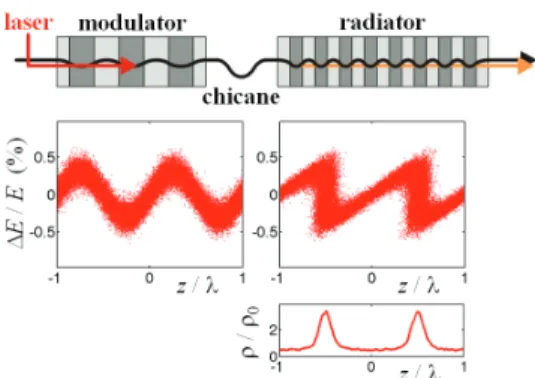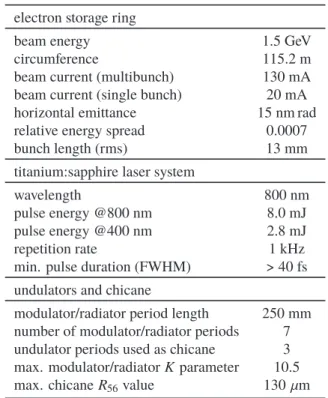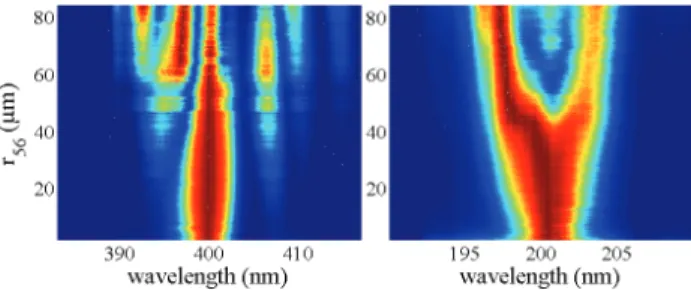SPECTRAL STUDIES OF ULTRASHORT AND COHERENT RADIATION PULSES AT THE DELTA STORAGE RING ∗
S. Khan † , F. H. Bahnsen, M. Bolsinger, F. Götz, S. Hilbrich, M. Jebramcik, N. M. Lockmann, C. Mai, A. Meyer auf der Heide, G. Shayeganrad, P. Ungelenk, D. Zimmermann,
Center for Synchrotron Radiation (DELTA), TU Dortmund University, 44227 Dortmund, Germany
Abstract
At the 1.5-GeV synchrotron light source DELTA operated by the TU Dortmund University, ultrashort and coherent radiation pulses in the VUV and THz regime are routinely generated by the interaction of electron bunches with fem- tosecond laser pulses. A laser-induced energy modulation is converted into a density modulation (microbunching) by a magnetic chicane, giving rise to coherent emission at har- monics of the initial laser pulses (coherent harmonic gen- eration, CHG). As a first step towards active control of the shape and spectrum of CHG pulses, spectral studies were performed under variation of the chicane strength and the laser properties. The spectral phase of the laser pulses was controlled by tuning the laser compressor and monitored us- ing FROG. A new autocorrelation method yields additional information on the pulse shape.
INTRODUCTION
Synchrotron radiation with short wavelengths is the stan- dard tool to study the structure of matter on the atomic scale.
However, synchrotron light pulses with durations of 30 to 100 ps (FWHM) are too long to temporally resolve atomic processes taking place on the sub-picosecond scale.
The need for radiation with short wavelength and short pulse duration has prompted new developments such as the free-electron laser (FEL) providing extremely brilliant short-wavelength radiation with femtosecond pulse dura- tion. To date, only four linac-based FEL facilities at short wavelengths are in single-user operation (FLASH, LCLS, SACLA, and FERMI) while more than 50 synchrotron light sources worldwide [1] supply multiple beamlines simul- taneously. It is therefore worthwhile to study methods which allow to generate shorter pulses at conventional syn- chrotron light sources. Some of these methods are borrowed from FEL seeding schemes in which the electric field of a femtosecond laser pulse modulates the energy of electrons within a short “slice” at the center of a longer electron bunch.
In a scheme known as coherent harmonic generation (CHG, Fig. 1) [2], a magnetic chicane converts the energy modula- tion generated in an undulator (“modulator”) into a density modulation (microbunching) giving rise to a short pulse of coherent radiation at harmonics of the laser wavelength in a second undulator (“radiator”). The power ratio between the short coherent and the long incoherent radiation component
∗Work supported by BMBF (05K13PE3 and 05K13PEC), DFG (INST 212/236-1 FUGG) and the Land NRW.
†shaukat.khan@tu-dortmund.de
Figure 1: Sketch of the short-pulse scheme CHG with the electron distribution in phase space (relative energy devia- tion ΔE/E versus longitudinal coordinate z in units of the laser wavelength λ) and electron density ρ(z/λ).
is given by
P
shortP
long= n
2shortb
2hn
long. (1)
With a bunching factor of b
h= 0 . 05 for harmonic number h , n
long= 10
10electrons in the whole bunch and n
short= 10
7electrons in the slice, to give an example, the power ratio would be 25. In the CHG scheme, the bunching factor is given by [3]
b
h= 2e
−h2B2/2| J
h(hAB)| , (2) where A = ΔE
max/σ
Eis the energy modulation am- plitude normalized to the rms energy spread, and B ≡ r
56(2π/λ)(σ
E/E) is the dimensionless chicane parameter for a seed wavelength λ and a longitudinal displacement Δz = r
56ΔE/E. However, Eq. 2 only holds for a constant modulation amplitude while, in reality, amplitude A follows the electric field distribution in the laser pulse, which can be assumed to be Gaussian in every coordinate. Thus, aver- aging over a 3-dimensional distribution A(x, y, z) leads to an “effective” bunching factor. If the laser beam is wider than the electron beam, at least the longitudinal dependence
A(z) must be considered.
As shown in Fig. 2 for a maximum bunching factor A
max= 5, the chicane parameter influences the CHG pulse shape.
Maximizing the CHG intensity results in a single bell-shaped pulse (green), while increasing the chicane parameter causes two maxima with overbunching between them (blue) or even three maxima (magenta). As recently discussed in [4] for the case of FERMI, a seeded FEL near Trieste/Italy, this opens Proceedings of IPAC2016, Busan, Korea WEPOW014
02 Photon Sources and Electron Accelerators A05 Synchrotron Radiation Facilities
ISBN 978-3-95450-147-2
2851 Copyright © 2016 CC-BY -3.0 and by the respecti v e authors
−60 −40 −20 0 20 40 60 0
20 40 60 80
time (fs) r 56 (µm)
−60 −40 −20 0 20 40 60
0 0.2 0.4 0.6 Amax = 5
time (fs)
(bunching factor) 2
Figure 2: Top: Contours of equal bunching factor as function of longitudinal position (in time units) and chicane strength r
56. Bottom: Bunching factor squared as function of time along the colored lines in the top figure.
up the possibility of tailoring the pulse shape according to the user requirements.
If the pulse shape cannot be measured directly, which is usually the case for femtosecond pulses of arbitrary wave- length, it may be deduced from the spectrum. This, however, depends not only on the bunching factor at a given wave- length, but also on the wavelength distribution along the seed pulse. If a coherent seed pulse is not chirped, i.e., if its wavelength is uniform, the temporal pattern causes spectral fringes according to its Fourier transform. If, on the other hand, the seed pulse is strongly chirped, two successive max- ima of the bunching factor not overlapping in wavelength would just lead to two maxima in the spectrum.
Observations similar to those discussed in [4] were made since 2013 with CHG radiation at the electron storage ring DELTA in Dortmund/Germany [5]. However, the interpre- tation of the spectra is not straightforward, as shown below, due to the nonlinear chirp of the seed pulses.
THE SHORT-PULSE FACILITY AT DELTA
The 1.5-GeV electron storage ring DELTA is operated as a synchrotron light source by the TU Dortmund University. In 2011, a short-pulse facility based on CHG was constructed to provide ultrashort coherent synchrotron radiation pulses in the VUV and THz regimes for users [6, 7]. The setup is shown in Fig. 2. Relevant parameters of the storage ring, the laser system, and the undulators are given in Table 1.
Seed pulses from a titanium:sapphire laser system are either focused directly through a beamline (BL 3) into the electromagnetic undulator U250 or are frequency-doubled first. The undulator, which usually supplies a beamline (BL 5) with soft-X-ray radiation, can be powered such that the 7 upstream/downstream periods act as modulator/radiator for the CHG scheme with a chicane between them. The energy modulation is performed at the full beam energy of 1.5 GeV during dedicated shifts, but was also tested during user operation (see Fig. 3).
laser
BL 3 BL 4
BL 5a
BL 5 U250
Figure 3: The short-pulse facility at DELTA comprising a laser system, a beamline (BL 3) sending seed pulses to the undulator U250, a diagnostics beamline (BL 4), a soft-x-ray beamline (BL 5), and a THz beamline (BL 5a).
A diagnostics beamline (BL 4) is used to observe the spa- tial overlap of laser and undulator radiation on screens and to establish the temporal overlap using a streak camera. Em- ploying a Czerny-Turner-type spectrometer, spectra down to wavelengths of 190 nm are recorded by rotating a grating while measuring the radiation intensity with an avalanche photodiode. The pulse height is digitized, averaged and sent to the EPICS-based control system [8] by a digital oscillo- scope. More recently, a second spectrometer was equipped with an image-intensified CCD (iCCD) camera [9]. Gat- ing with minimum window of 2 ns allows to record spectra without the background of 2600 incoherent pulses (in single- bunch mode) between consecutive CHG pulses. Apart from much faster data acquisition (4 images per second compared to one grating scan over 8 minutes), the iCCD camera adds a new quality by allowing to obtain single-shot spectra.
Radiation at shorter wavelengths requires vacuum and is studied using a soft-X-ray beamline (BL 5) operated by the Forschungszentrum Jülich. Spectra are obtained by scanning
Table 1: Parameters of the DELTA Short-pulse Facility electron storage ring
beam energy 1.5 GeV
circumference 115.2 m
beam current (multibunch) 130 mA beam current (single bunch) 20 mA
horizontal emittance 15 nm rad
relative energy spread 0.0007
bunch length (rms) 13 mm
titanium:sapphire laser system
wavelength 800 nm
pulse energy @800 nm 8.0 mJ
pulse energy @400 nm 2.8 mJ
repetition rate 1 kHz
min. pulse duration (FWHM) > 40 fs undulators and chicane
modulator/radiator period length 250 mm number of modulator/radiator periods 7 undulator periods used as chicane 3 max. modulator/radiator K parameter 10.5
max. chicane R
56value 130 μm
WEPOW014 Proceedings of IPAC2016, Busan, Korea
ISBN 978-3-95450-147-2 2852
Copyright © 2016 CC-BY -3.0 and by the respecti v e authors
02 Photon Sources and Electron Accelerators
A05 Synchrotron Radiation Facilities
CHG signal (a.u.)spec. phase (rad) 4
r56= 70μm 0
1 70μm
0 1
21μm
385 400 415
0
1 21μm
385 400 415
0 1
70μm 0
1
21μm
385 400 415
0 1
780 800 820
0 2
780 800 820
0 2 4
780 800 820
0 2 4 wavelength (nm)
wavelength (nm)
55fs, pos. chirp 44fs, min. chirp
55fs, neg. chirp
Figure 4: Spectral phase of 800-nm seed pulses (bottom) and CHG spectra at the second harmonic normalized to their maximum with the chicane set to r
56= 21 μm (center) and 70 μ m (top). The measurements were performed with three different settings of the laser compressor. From left to right:
negative chirp, shortest pulse, positive chirp.
a plane-grating monochromator and recording the photoelec- tron yield from a sample.
The short-pulse facility also comprises a dedicated beam- line for terahertz (THz) radiation. The energy-dependent path length of off-energy electrons in the storage-ring lat- tice causes a sub-picosecond dip in the longitudinal electron distribution which gives rise to THz and sub-THz radiation over several turns [10]. See [11] for recent results.
SPECTRA OF CHG RADIATION
With seed wavelengths of 800 nm and 400 nm, CHG spectra were recorded at different harmonics under variation of the chicane strength, typically between r
56= 5 μ m and 120 μ m, to which a value of 10 μ m for the longitudinal dis- persion of the modulator must be added. The compression of the laser pulses after amplification was varied, resulting in typical pulse durations between 40 fs and 60 fs (FWHM).
In the case of seeding with 800 nm, the temporal and spec- tral pulse properties were recorded using a FROG apparatus (frequency-resolved optical gating) [12]. However, air and the vacuum window on the way to the undulator may signif- icantly modify these properties.
As an example, Fig. 4 shows spectra of second-harmonic CHG radiation while seeding with 800 nm pulses. As indi- cated by the spectral phase for three different compressor settings, the wavelength variation along the pulse is nonlin- ear. Otherwise, the spectral phase would be a parabola (or a straight line in the case of no chirp). For r
56= 70 μm, a CHG double pulse can be assumed and the spectra clearly ex- hibit interference fringes. Even at the lower r
56value, which corresponds to a single maximum of the bunching factor, the spectra are distorted by nonzero chirp. The interaction of chirped laser pulses including effects of the laser beam waist, wavefront curvature and Guoy phase (see e.g. [13]) was simu- lated using a self-written code. The resulting electron energy distribution was subjected to longitudinal dispersion and the bunching factor as function of wavelength was computed in 0.5-nm steps. In contrast to [4], the observed spectral
Figure 5: Sequence of 600 single-shot spectra of CHG radi- ation under slow variation of the chicane strength r
56while seeding with 800-nm (left) and 400-nm (right) laser pulses.
features are not reproduced under the assumption of a linear chirp. The next step will be to repeat the simulation with a seed pulse constructed from the measured spectral phase.
When seeding with 400-nm pulses, the laser compressor is usually tuned to maximize the power of the frequency- doubled pulses. In this case, the CHG spectra measured around 200 nm show a single peak at low r
56values and two peaks at higher chicane settings, as expected from seeding with a strongly chirped pulse. First measurements obtained using the iCCD camera are shown in Fig. 5. No equipment is available to directly characterize the 400-nm pulses, and since the second-harmonic generation is performed in air, the seed pulses will be chirped along their way through air and the vacuum window. Indirect evidence for the pulse shape comes from an autocorrelator-like measurement, in which modulator and radiator are both set to the seed wavelength, allowing for a twofold energy modulation with the seed pulse delayed by the chicane. While increasing the delay, a twofold modulation of the same electrons is indicated by oscillatory variations of the THz signal. In the test case shown in Fig. 6 with 800-nm seeding, the envelope of the THz oscillation amplitude resembles the pulse shape obtained by FROG, confirming the validity of the method.
0 50 100 150
0 0.5 1
signal (a.u.)
THzraw data
0 50 100 150
0 0.5 1
signal (a.u.)
THzamplitude FROG
0 50 100 150
0 0.5 1
delay (fs)
signal (a.u.)
FROG


